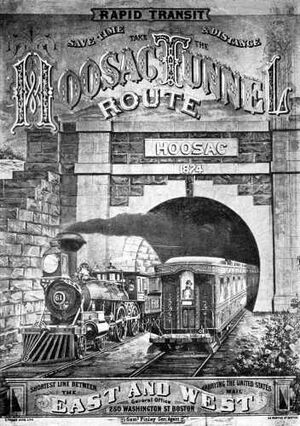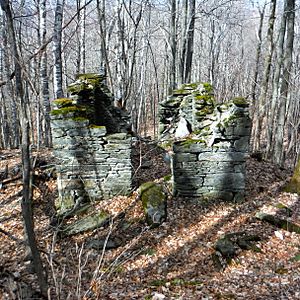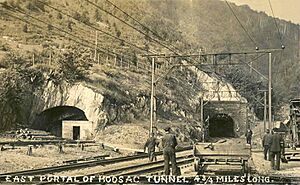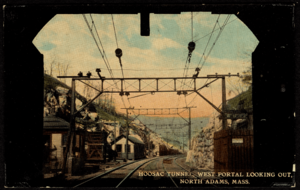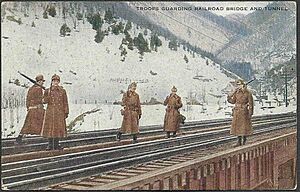Hoosac Tunnel facts for kids
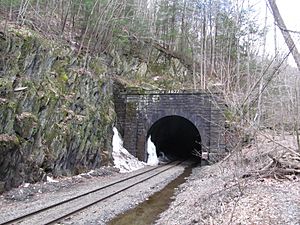 |
|
| The east portal of the Hoosac Tunnel in 2013 | |
| Overview | |
|---|---|
| Line | PAS Freight Main Line |
| Location | Western Massachusetts |
| Status | Operating |
| System | Pan Am Southern |
| Operation | |
| Work begun | 1851 |
| Owner | Pan Am Southern LLC |
| Operator | Springfield Terminal Railway |
| Traffic | Train |
| Character | Freight |
| Technical | |
| Construction | 1851–1873 |
| Length | 25,081 feet (7,645 m) long |
| No. of tracks | Single |
| Gauge | 1,435 mm (4 ft 8 1⁄2 in) standard gauge |
| Operating speed | 25 miles per hour (40 km/h) |
| Tunnel clearance | 20 feet (6.1 m) |
| Width | 24 feet (7.3 m) |
The Hoosac Tunnel is a very long railroad tunnel in western Massachusetts. It's about 4.75 miles (7.6 kilometers) long. The tunnel goes through the Hoosac Range, which is part of Vermont's Green Mountains. It connects the town of Florida on the east to the city of North Adams on the west.
Work on the tunnel started in 1851 and finished in 1875. It cost $21 million, much more than the first guess of $2 million. When it was done, it was the second-longest tunnel in the world. Only the Mont Cenis Tunnel in the Alps was longer. It was also the longest tunnel in North America until 1916. Today, it's still the longest active transportation tunnel east of the Rocky Mountains. In 1975, the American Society of Civil Engineers named it a Historic Civil Engineering Landmark.
The word "Hoosac" comes from an old Native American language. It means "place of stones."
Contents
Building the Hoosac Tunnel
Early Ideas and Start of Work
The idea for the tunnel first came up in 1819. People wanted to build a canal to connect Boston to Upstate New York. This canal would have used the Deerfield River and the Hoosic River. That canal idea was put aside. Later, the tunnel project became part of the new Troy and Greenfield Railroad.
Some people called the project "The Great Bore." They didn't think it would ever be finished. One critic, Oliver Wendell Holmes, Jr., even joked about it.
Alvah Crocker was a key supporter of the tunnel. He owned a paper mill and helped start the Fitchburg Railroad in 1841. This railroad connected Boston to Fitchburg. In 1848, Crocker helped get a special permission, called a charter, for the Troy & Greenfield Railroad. This charter included plans for the Hoosac Tunnel.
Work on the tunnel began in 1851. The state of Massachusetts offered $2 million to help. Edward Wellman Serrell and Company started digging in 1855. In 1856, Herman Haupt became the main engineer.
The Boston and Albany Railroad was a rival company. They had a different route through the state. They worked to stop the state from funding the tunnel in 1861. This caused Haupt's company to go bankrupt, and work stopped for a while. Haupt had dug about a fifth of the tunnel by then.
Finishing the Tunnel
In 1862, the state of Massachusetts took over the project. They sent an engineer to Europe to learn new ways to dig tunnels. These new methods included using nitroglycerin and compressed air. In 1863, the state restarted the project. Alvah Crocker became the superintendent of railroads, and Thomas Doane became the chief engineer.
In 1868, the state gave $5 million more to finish the tunnel. Canadian engineers Walter Shanly and his brother Francis took over the digging. They stayed until the tunnel was bored all the way through.
The final chief engineer was Bernard N. Farren. He took over in November 1874. On Thanksgiving Day that year, the last 16 feet (4.9 meters) of rock were removed. This connected the two sides of the tunnel. Farren finished the rest of the work, like making parts of the tunnel bigger and stronger. The first train went through the tunnel on February 9, 1875.
New Technology for Tunnel Building
Building the Hoosac Tunnel meant digging out 2,000,000 tons of rock. Early on, a "stone-cutting machine" was tried in 1853, but it broke down after digging only 10 feet (3 meters). So, workers went back to digging by hand. Later, they used the Burleigh Drilling-machine, which was one of the first pneumatic drills.
This project was also the first time nitroglycerin was used on a large scale in the United States. It was also the first time electric blasting caps were used for explosions.
To speed things up, workers dug a "Central Shaft" down from the top of the mountain. This shaft was completed in 1870. It allowed workers to dig outwards from the middle, meeting the tunnels being dug from the east and west ends. An elevator, 1,000 feet (300 meters) tall, was built to lift the dug-out rock from the shaft.
One big challenge was making sure all the tunnel parts lined up perfectly. Engineers cleared a path over the mountain. They stretched a straight line from the east to west ends using "sighting posts." In 1866, Thomas Doane built six special towers to help with this.
These alignment towers helped keep the tunnel on its correct path. Surveys were done repeatedly to check the line. On December 12, 1872, the tunnel from the east end met the tunnel from the Central Shaft. They were off by less than an inch (9/16 inch or 1.4 centimeters)! This was an amazing achievement for that time. On November 27, 1873, the rest of the tunnel connected to the west end.
The Hoosac Tunnel project is seen as the start of modern tunnel building technology.
How the Tunnel is Used
The Troy and Boston Railroad opened in 1859. It connected Troy, New York, to North Adams, Massachusetts, at the west end of the tunnel.
After the state took over the tunnel project in 1863, other railroad companies wanted to use it. The first train went through the tunnel on February 9, 1875. Regular train service between Boston and Troy, New York, started the next year. The Fitchburg Railroad bought the tunnel in 1877. Later, the Boston and Maine Railroad bought the Fitchburg Railroad in 1900.
In 1910, the tunnel was given electricity. This was to reduce smoke and make trains go faster. By 1913, so many trains were using the tunnel (70,000 cars a month!) that the power plant couldn't keep up. More power was brought in from a nearby dam. In 1926, part of the tunnel was deepened by 1.5 feet (0.46 meters).
The electricity was removed in 1946 when diesel trains became common. A large fan was put in the Central Shaft to remove the diesel fumes. Today, this fan still works, but on low power because fewer trains use the tunnel.
The last regular passenger train, called the Minute Man, went through the tunnel in 1958.
In 2009, the tunnel became owned by Pan Am Southern. This is a company jointly owned by Pan Am Railways and Norfolk Southern Railway. Freight trains through the tunnel are run by Springfield Terminal Railway.
Today, the tunnel is mainly used for freight trains. Sometimes, special excursion trains use it too. In 1957, it was changed to a single track. In 1997 and 2007, the tunnel was made taller. This was done by lowering the track and grinding down the roof. This allowed bigger freight cars, like those carrying truck trailers or cars, to pass through. There are plans to make it even taller for "double-stack" container trains.
As of 2020, about eight freight trains use the tunnel every day.
On February 12, 2020, part of the tunnel collapsed near the west end. More collapses happened in the following days. Crews worked hard to fix it. Trains had to go on different routes while the tunnel was closed. The tunnel reopened on April 4, 2020, after being closed for two months. Some repairs were still ongoing.
Images for kids


